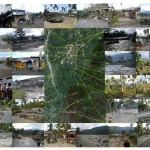
Projections on seasonal temperature increase and rainfall change, and total frequency of extreme events nationally and in the provinces using the mid-range scenario outputs are presented in this chapter. A comparison of these values with the high- and low- range scenarios in 2020 and 2050 is provided in the technical annexes.
It is to be noted that all the projected changes are relative to the baseline (1971-2000) climate. For example, a projected 1.0 C-increase in 2020 in a province means that 1.0 C is added to the baseline mean temperature value of the province as indicated in the table to arrive at the value of projected mean temperature. Therefore, if the baseline mean temperature is 27.8 C, then the projected mean temperature in the future is (27.8 C + 1.0 C) or 28.8 C.
In a similar manner, for say, a +25%-rainfall change in a province, it means that 25% of the seasonal mean rainfall value in the said province (from table of baseline climate) is added to the mean value. Thus, if the baseline seasonal rainfall is 900mm, then projected rainfall in the future is 900mm + 225mm or 1125mm.
This means that we are already experiencing some of the climate change shown in the findings under the mid-range scenario, as we are now into the second decade of the century. Classification of climate used the Coronas four climate types (Types I to IV), based on monthly rainfall received during the year. A province is considered to have Type I climate if there is a distinct dry and a wet season; wet from June to November and dry, the rest of the year. Type II climate is when there is no dry period at all throughout the year, with a pronounced wet season from November to February. On the other hand, Type III climate is when there is a short dry season, usually from February to April, and Type IV climate is when the rainfall is almost evenly distributed during the whole year.





